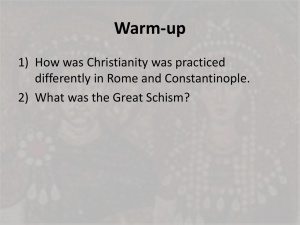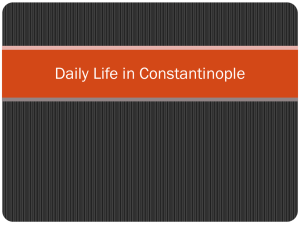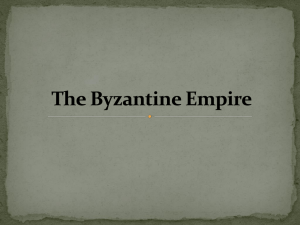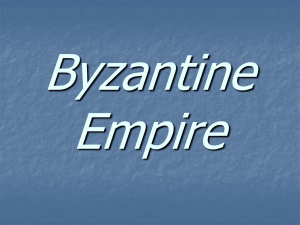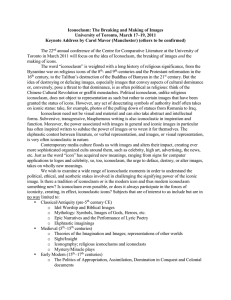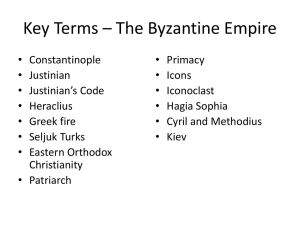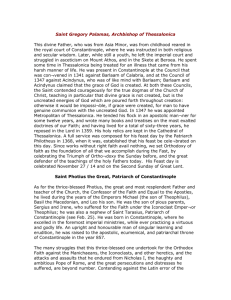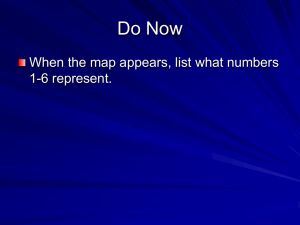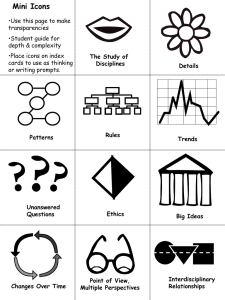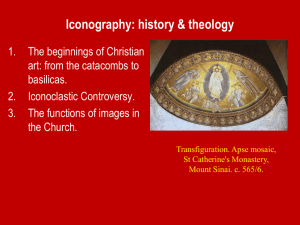Word - Stephen J. Shoemaker
advertisement
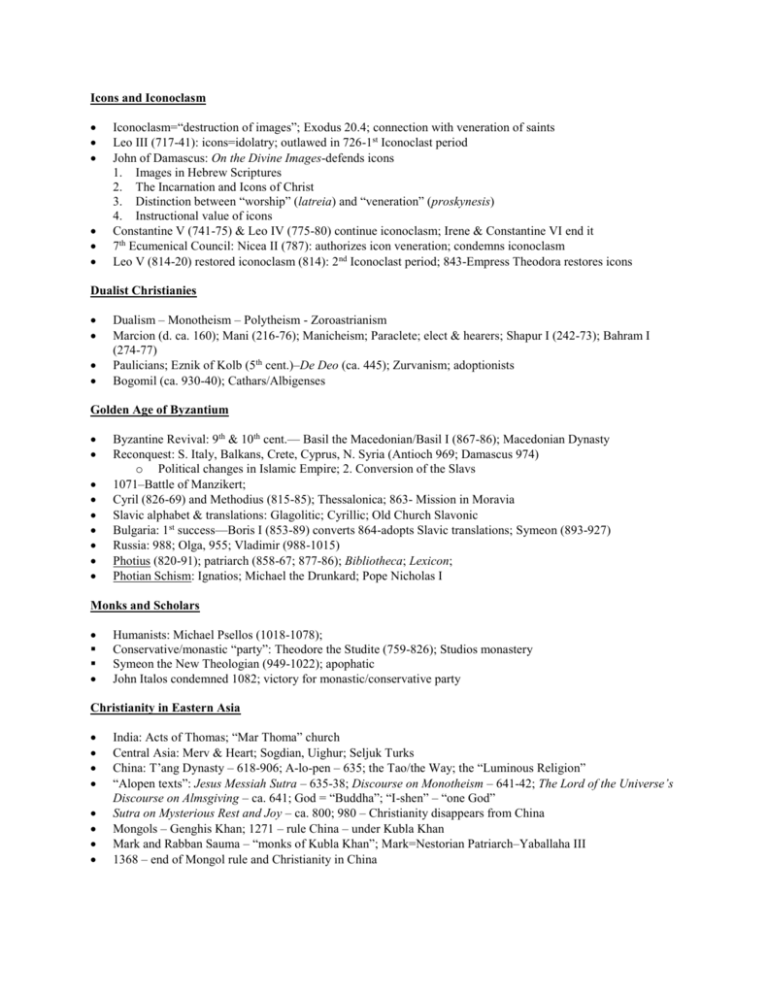
Icons and Iconoclasm Iconoclasm=“destruction of images”; Exodus 20.4; connection with veneration of saints Leo III (717-41): icons=idolatry; outlawed in 726-1st Iconoclast period John of Damascus: On the Divine Images-defends icons 1. Images in Hebrew Scriptures 2. The Incarnation and Icons of Christ 3. Distinction between “worship” (latreia) and “veneration” (proskynesis) 4. Instructional value of icons Constantine V (741-75) & Leo IV (775-80) continue iconoclasm; Irene & Constantine VI end it 7th Ecumenical Council: Nicea II (787): authorizes icon veneration; condemns iconoclasm Leo V (814-20) restored iconoclasm (814): 2 nd Iconoclast period; 843-Empress Theodora restores icons Dualist Christianies Dualism – Monotheism – Polytheism - Zoroastrianism Marcion (d. ca. 160); Mani (216-76); Manicheism; Paraclete; elect & hearers; Shapur I (242-73); Bahram I (274-77) Paulicians; Eznik of Kolb (5th cent.)–De Deo (ca. 445); Zurvanism; adoptionists Bogomil (ca. 930-40); Cathars/Albigenses Golden Age of Byzantium Byzantine Revival: 9th & 10th cent.— Basil the Macedonian/Basil I (867-86); Macedonian Dynasty Reconquest: S. Italy, Balkans, Crete, Cyprus, N. Syria (Antioch 969; Damascus 974) o Political changes in Islamic Empire; 2. Conversion of the Slavs 1071–Battle of Manzikert; Cyril (826-69) and Methodius (815-85); Thessalonica; 863- Mission in Moravia Slavic alphabet & translations: Glagolitic; Cyrillic; Old Church Slavonic Bulgaria: 1st success—Boris I (853-89) converts 864-adopts Slavic translations; Symeon (893-927) Russia: 988; Olga, 955; Vladimir (988-1015) Photius (820-91); patriarch (858-67; 877-86); Bibliotheca; Lexicon; Photian Schism: Ignatios; Michael the Drunkard; Pope Nicholas I Monks and Scholars Humanists: Michael Psellos (1018-1078); Conservative/monastic “party”: Theodore the Studite (759-826); Studios monastery Symeon the New Theologian (949-1022); apophatic John Italos condemned 1082; victory for monastic/conservative party Christianity in Eastern Asia India: Acts of Thomas; “Mar Thoma” church Central Asia: Merv & Heart; Sogdian, Uighur; Seljuk Turks China: T’ang Dynasty – 618-906; A-lo-pen – 635; the Tao/the Way; the “Luminous Religion” “Alopen texts”: Jesus Messiah Sutra – 635-38; Discourse on Monotheism – 641-42; The Lord of the Universe’s Discourse on Almsgiving – ca. 641; God = “Buddha”; “I-shen” – “one God” Sutra on Mysterious Rest and Joy – ca. 800; 980 – Christianity disappears from China Mongols – Genghis Khan; 1271 – rule China – under Kubla Khan Mark and Rabban Sauma – “monks of Kubla Khan”; Mark=Nestorian Patriarch–Yaballaha III 1368 – end of Mongol rule and Christianity in China Christianity East & West: The Crusades (Crusader=Cross-bearer) Sealed the separation of the two churches Turks—Battle of Manzikert—1071; 1095: Pope Urban II calls for Crusades Crusaders converge at Constantinople: “1st Crusade” 1097: Take the Turkish capital at Nicea; 1098: Antioch; 1099: Jerusalem Crusader Kingdoms: Jerusalem, Antioch, Edessa, Tripoli 3 More “Crusades” – 2nd—Loss of NE Syria (Edessa) to Muslims in 1144 3rd—Kingdom of Jerusalem Falls to Salah ed-Din in 1187; Akko/Acre 4th—Diverted to Constantinople in 1204; Alexius: Deposed Byzantine Emperor Western Crusaders pillage Constantinople; take over much of the Byzantine Empire 3 centers of Byzantine resistence: 1). western Greece – Despotate of Epirus; 2) western Asia minor – Empire of Nicea; 3) NE Asian coast – Empire of Trebizond; Nicea most legitimacy 1259: Empire of Nicea begins reconquest; 1261: regains Constantinople; Michael VIII Paleologos Christainity East & West: Theology Differences already visible in 5th century Intensify in the 8th: 800—Charlemagne crowned Holy Roman emperor Papal Claims: “First among equals” - Pope claims authority over all Christendom: East doesn’t recognize; Rome and Photius Filioque - 589 council of Toledo; council in Aachen (809) - Charlemagne, increasing Western usage; Rome adopts 1000; Photius: Mystagogy of the Holy Spirit Liturgical Differences - around 1000: try to impose on each other; Normans in S. Italy; use of leavened bread at Eucharist July 1054—“traditional” date of separation; Cardinal Humbert—Papal ambassador Demetrios Kydones (1323-1397/98); Apology; Thomas Aquinas, Scholasticism Hesychasm & Gregory Palamas (1296-1359) Nicephorus the Hesycast (13th cent.); Mt. Sinai, Mt. Athos; Hesychasm – hesuchia = quietness; stillness Technique: 1) posture; 2) breathing/Jesus prayer; 3) imagined union of heart and mind; elimination of thought Gregory Palamas (1296-1359); Triads – defense of Hesychasm Barlaam the Calabrian (1290-1348) – attacks Hesycham ca. 1330; influence of Western Scholasticism Challenged possibility of direct knowledge of God, union with God; also challenged Deification Uncreated energies of God vs. essence of God Christianity in the Balkans 865 – conversion of Bulgarians; Serbs - 867-74 Sava (1175-1235); 1207 – involved in Serbian politics; 1219 – Sava head of Serbian church; autocephalous 1204: Pope makes Bulgarians independent 1235: Constantinople makes Bulgarians independent; Bulgarian Patriarch Bosina: Bogomils in Serbia 1150; Patarenes; 1500-Islam 1359: Romanian church organized; claimed independence 1859; granted 1885 The Fall of Constantinople 1433 – Byzantines approach Western Council; 1439 – Council of Florence; July 6, 1439: union 1443 – Western Army sent; 1444 – defeated by Turks 29 May 1453 – Fall of Constantinople to Ottoman Turks; 1460 – S. Greece; 1461 – Trebizond Christianity in Late Byzantium Nicholas Kavasilas (ca. 1323-91); Philokalia Greek Revival – George Gemistos Plethon (ca. 1360-1452); Mistra; Sparta; Book of Laws; On the Differences of Aristotle from Plato; Cardinal Bessarion (1400-1472) Origins of Russian Christianity 988 – Vladimir (d. 1015); the Rus’ – Scandinavians; 860 – assault on Constantinople Cherson; Crimea; Cyril; 882 – Kiev center of Russia Princess Olga – converted ca. 955 (d. 969) Metropolitan of Kiev; Hilarion – metropolitan 1051-54; Sermon on Law & Grace Instruction of Vladimir Monomakh (1053-1125); Novgorod The Russian Church under the Mongols City of Vladimir; Grand Prince 1237-40 – Mongols conquer Russia; “the Golden Horde”; Serai = capital; Lithuania & Poland Novgorod and the Crusaders; Alexander Nevsky – Grand Prince of Vladimir (1252-63) “Galicia” (western Ukraine/Byelorussia) 1328 – Rise of Moscow 1380 – Russian victory against Mongols; 1447 – end of Mongol Rule 1386 – Lithuanians become Catholic Sergius of Radonezh (1314-92) Moscow as the Third Rome 1433 – Isidore metropolitan of Kiev – Plethon & Bessarion; 1437 – Isidore in Russia; to Florence 1441 – returns from Florence – accepted union; a Cardinal; 1443 – fled to Italy 1448 – Russian bishops appoint metropolitan Jonas – independence; recognized by Constantinople in 1589 legend of the “White Cowl”; Filofei – 1510 Judaizers – 1470 in Novgorod – Zachariah; 1479 - Ivan III, Grand Prince of Moscow – appoints Judaizers to high positions; Theodore Kuritsyn – Ivan’s chief diplomat – a Judaizer 1485 – crackdown on Judaizers in Novgorod; 1490 – metropolitan = Judaizer 1497 – death of Kuritsyn; 1505 – council condemns Judaizers Possessors & Non-Possessors: Nilus = Non-Possessor leader – hesychast Joseph = Possessor leader –also known as Josephites
